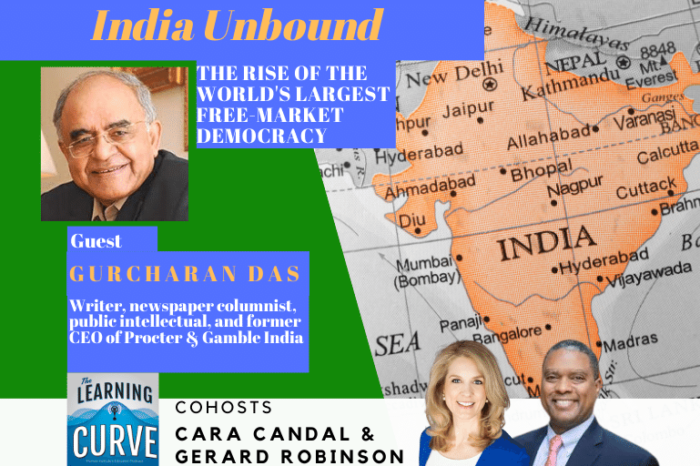India Unbound: Gurcharan Das on the Rise of the World’s Largest Free-Market Democracy
/0 Comments/in Featured, News, Podcast /by Editorial StaffGet new episodes of The Learning Curve in your inbox!
Read a transcript here:
[00:00:00] Cara Candal: Well hello, Learning Curve listeners. This is Cara Candal here with Gerard Robinson. Gerard, I missed you last week. As you know, I was out and about doing some interesting international travel, and big news here in Boston.
[00:00:14] You might have already talked about this last week, but we experienced a deep freeze, which meant I experienced some typical Northeastern housing issues when all of our pipes burst and we had a flood. So, it’s been some good times. It’s been some really good times. Wow.
[00:00:32] Gerard Robinson: Wow. Well, how are you and the little ones—
[00:00:36] Cara: No, we’re great. And it could be a lot worse. let me tell you, it could have been a lot worse. So, but I have to share that, you know, I’ve never gone through a time in my life where I’ve have been more than 24 hours without just being able to turn on a faucet and enjoy water in all of the various things that water does for us. And so, I spent many days just telling my children, do you have any clue how many people in this world do not live with running water? You know, the small, small things that you take for granted. I’m not going to pretend that I’m a martyr and I ever want a taste of that again. But it was, quite incredible.
And here, you know, Boston was, our producers will let me know if I’m wrong, but I think we got down to like negative 22 or something probably. And then, by that afternoon it was back up to like 55. So just, Mother Nature keeps you guessing, doesn’t it? I, I hope you’re well, Gerard.
I missed you last week, I did get to enjoy some downtime with the family after the drama, but, how are you doing?
[00:01:36] Gerard: Doing well. Well, I had no idea it was that bad. I’m glad you were up. And you’re right. There are millions of people who have what we’ll call the theara crisis every day. And two years ago, we had something similar, more because of the weather, not because of a pipe, but for three days, we had no heat, we slept in the bed as a family of four. We finally got a [00:02:00] hotel room, but we lived like the Pilgrims were living.
[00:02:03] Cara: No, I remember, yeah, I remember that because you are such an intrepid podcast host that you were recording from the car. Yes, I remember that. Very remember vividly, right. See, Listeners, we will come to you under any circumstances, that’s just how important this podcast is to us. Oh, well, everybody’s recovered. We’ve got a really interesting guest today, Gerard, so I want to get to that. But man, there’s also a lot in the news. We haven’t corresponded about this yet. So I don’t know what your story of the week is, but I’ve, picked one from Jolly Old England, where I know you spent a lot of time. I don’t know if you know this jar, but when I was writing my dissertation, I looked at three different countries in comparison to the U.S. in terms of how they fund schools and specifically in terms of how they, target resources to families with the least access, let’s put it that way. and one of those countries was England. So, I spent a lot of time studying their system. And today I’ve got a story coming out of The Guardian. This title’s going sound eerily familiar to anything that we would hear here in the us and it is, a “Quarter of a million children enter secondary school without basic maths.”
[00:03:12] Yes, maths, plural, and English. So, this has nothing to do with English system of school funding, but one of the things that I learned and didn’t know when I was doing my dissertation is just how, how often the U.S. and British education systems mirror one another. And I mean that by saying I think that we tend to take both good and bad ideas from one another, and you can sort of watch the pendulum swing. Of course, their system of education is, it goes back a bit further than ours in many respects, but this is about really the learning loss that so many countries are still dealing with and Britain and England, as well.
[00:03:51] So, a quote from this article—and I want to put this in context because we talked about U.S. NAEP scores here a couple months ago—I think it was in October, the release, so there was a goal in Britain, in England that 90% of students would be proficient or better in math, in reading, in England and pre-pandemic they were making some gains toward that goal. So, post-pandemic, what we know in England is that 41% of year six pupils left primary school without meeting the expected standards in literacy and math. That was 41%.
[00:04:29] Now, if we look here to the us, as we all know, we experienced similar declines here in the U.S. We had more in the range of, in many cases, only 30% of kids being proficient. I’ll use, you know, a place right here in Boston. We often call it, as some say, it’s the best performing urban school district in the country and we’ve talked a lot on this show about the troubles that that district is facing. And in that district, only 33% of students were really even proficient before NAEP. Putting in context these slumps, as some are calling it, I think that we should really watch our language here because I’m afraid it’s probably more than a slump.
[00:05:08] We’re talking about a generation of kids, as you and I have gone on about before, that are starting off so behind or have lost so much learning due to the pandemic that this slump might be more than a slump. It could, unfortunately, persist for a generation. What was interesting to me about this article, Gerard, not just the comparison, but the comparative slump in England, and of course it’s the same as here. We worry about specific groups of kids. Those who lost the most learning had the least access, and they tend to come from, families that had the least access in the first place, that they’re the ones that are suffering the most. And the conversation that I find really interesting is that around like, OK, so how do you fix it?
So, this article goes in to talk about the nonprofit that did this study and one of their big recommendations, which was very broadly parent engagement, which is great. Parent engagement is incredibly important, right? Like, so part of the argument is, oh, we’ve got a teacher shortage crisis just as we do here. Let’s get parents more engaged and, give kids more time learning at home. What strikes me as really interesting about this, Gerard, is that, for example, I’m going to be going to—on Thursday, the Harvard program on educational policy and governance is hosting our friend Marguerite Rosa, to talk about fiscal cliffs and to talk about ESSA spending.
One of the things that’s been lacking in this country, in my opinion, in our country, and seems to be lacking in England as well is a narrative around so, what are the things that we know we should be doing that we’re not? So, can parent engagement work? Of course it can, but I want more broad—I don’t want such a broad brush on that. I want some tactical information. What exactly do we expect parents to do? And here, what are the things that we’re doing to invest in proven practices? More time on learning, extended school day, extended school year, high dosage tutoring. This just struck me as really interesting, Gerard, that here and across the pond we’re having the same problems.
[00:07:04] We’re having the same discussions, and to my mind, the solutions, at least in the mass media, and this is of course from The Guardian, you can’t expect something super in-depth. That the solutions we’re offering up here seem to be a bit wanting. So, this is a call from me, from the Learning Curve to get more experts involved and let’s look back at those proven practices that have research and evidence and data behind them that we know work and start investing in those instead of calling for these sort of Band-aid solutions when we know kids are failing to get up to standard in math and reading.
Gerard, what do you think.
[00:07:41] GR: As you and some of the listeners may remember, I had a chance to travel to England last January to take a look at a group of schools that were under support from a group of scholars at the Jubilee Center. And what they decided to do was to let best practices and best research drive it. So, I’m with you on that. I don’t disagree, really, with anything you had to say. I do think there’s some things the U.K. now, well, that England can learn from us, as relates to decades of trying to do the Band-aid approach.
It will only work for so long and the water will find a way of seeping out. So, great story. And, uh, we wish our colleagues, friends, students, parents, and elected officials on the other side of the pond. Good luck because there are some times where they can look our way and try to do something differently. So it’s funny you talk about funding on this side of the pond. My story of the week is from the Philadelphia Inquirer, and since I mentioned Philadelphia, I want to give a congrats out to the people of Kansas City, for their Super Bowl. My condolences to the people of Philadelphia for the loss. I was actually rooting for Philadelphia, having lived and worked there in the past, but it was a great game.
But there are a lot of people in Philadelphia independent of football who are pretty excited right now because as the article notes in the opening, Commonwealth Court ruling is a massive win for education choice advocates, and this is from Jennifer Stephano, February 13, 2023. We have talked a good deal about school finance on The Learning Curve.
We’ve had scholars, we’ve had attorneys, and we’ve had parents on the show. So, we can say here on this show that there is actually a ruling from the Pennsylvania Commonwealth Court, which affirmed that the Pennsylvania Constitution has said this all along.
Kids deserve their education to be about meaningful opportunity, not a flawed and antiquated system. So, meaningful opportunity is something that a lot of education lawyers, judges and advocates are going to hold onto for quite some time in Pennsylvania. Get this, the ruling is 786 pages. I can guarantee you and the readers that I have not read all 786 pages as of yet, but having looked at some of the documents, having looked at some of the reporting, and also having leaned over to speak to Professor Robinson, this is a major victory. And it’s not only a major victory just for school choice advocates, many of them being students of color who have used choice in that state, tax credit, opportunity scholarship, or otherwise, and to move to better opportunities. But the judge in this case said, listen, this is the responsibility of the state.
[00:10:35] The state has got to invest money to make sure that students have A, the money they need, B, educators have the resources they need to do their craft, and C, that families have faith that the schools they’re sending their children to, in fact are going to prepare them for the world that they live in. We all know, I mean you just mentioned for England, we know the learning lost and all the other challenges, so I won’t belabor that point, but when the Pennsylvania court said that, really, we’re calling for a coefficient system of public education, it’s pretty clear that families are going to push that the money should follow the child.
Now, Pennsylvania’s a large state, a lot of school systems. They’ve got some that are working well. They have some that are challenged, but this is going to be something to watch. Naturally when we talk about school finance, funding is going to be a big area. One of our former guests, Eric Hanushek, in a 2016 study that he identified, he said, listen, we’re looking at approximately $19,900 per student that’s actually coming from the Commonwealth Foundation. But Eric followed up, well, had an earlier report where he said that just because you have more money, does not necessarily mean you’re going to have better academic outcomes. I often say to my friends that when we talk about school finance, that yes, school finance is just not a revenue conversation. It’s also an expenditure conversation. So, I’m going to watch this with great interest.
School financial litigation is taking place across the country, and in some places states have settled, like in California and Detroit, in the Gary B. case and in the Etta T. case. Uh, but here a judge has ruled. So, what are your thoughts?
[00:12:14] Cara: I’m just fascinated that it’s been decades we’ve been having these conversations, right. And I think it’s a great ruling out of Pennsylvania. I think it’s the right ruling. It’s also huge implications for just the extent to which funding needs to follow kids in this country, not just for choice, like it, it needs to follow kids. it doesn’t belong to bureaucracies, it belongs to families.
And the more we push on defining what the actual state responsibility is, for education, the more important I was, um, I was up in New Hampshire yesterday with our neighbors to the north here in Massachusetts. Just wonderful, wonderful group of people. And we had, a very, I would say, robust discussion about student-centered funding and what it means to reform, a system of school finance.
And it’s got, you know, there are implications every which way. Uh, a lot of people get really nervous when you talk about state responsibility, a lot of people really like local control in the US and don’t want states involved, but at the end of the day, it’s really important to determine where responsibility lies and, with whom responsibility lies. Who is accountable when a system systemically fails kids again and again?
So, long time coming here in Pennsylvania, I’m happy to see this resurfaced. It’s a really important conversation and I think that, too many folks who sent their kids to school in this country who are products of public schools in this country, really don’t have a grasp on how these systems work both for and against us. And, uh, working through the courts is really the only proven way to get it done. So yes, we will be, we’ll be watching this case and others that might follow. Gerard coming up, we’ve got waiting for us a guest that I’m really, really excited about.
[00:14:01] You know, listeners, we always try and bring you really diverse guests with diverse perspectives and diverse accomplishments, I should say. We’ve got so many just amazing people. I don’t know where our producer, Jamie Gass, is able to find all these folks. But coming to us all the way from India, we are going to be speaking with Gurcharan Das, an author and former CEO of Procter & Gamble in India, author of many books, some of which we’re going to talk about, most of which we’re going to talk about is the book India Unbound. So really excited for that. Listeners stay with us for just a moment because we’re going to be back after this.
[00:14:57] Welcome back listeners. We are here with Gurcharan Das, an author and former CEO of Procter & Gamble India. He authored a much-acclaimed trilogy based on the classical Indian ideal of life’s goals. India Unbound was the first on artha, material wellbeing, and is available in 19 languages and filmed by the BBC. The second, The Difficulty of Being Good, on dharma or moral wellbeing. And finally, Kama, the Riddle of Desire is on the third goal. He writes a regular column for the Times of India and five Indian language papers and contributes to the Financial Times, the Wall Street Journal, the New York Times, and Foreign Affairs. He’s a speaker to some of the world’s largest corporations and is also the author of a novel, a book of essays, and prize-winning plays. Mr. Das studied philosophy at Harvard University and later attended Harvard Business School. He is presently editing for Penguin, the story of Indian Business in 15 volumes and lives in Delhi with his wife. Gurcharan Das, welcome to The Living Curve.
Gurchuran Das: Thank you.
Cara: Oh, we’re so excited to have you. I have to share very quickly that one of the greatest memories of my life is being able to spend a summer traveling India with my best friend from high school whose family, many of whom were still in India. And so, I stayed in many a welcoming home all the way from Delhi to what was then called Madras to Chenai and what a wonderful, beautiful country experience. And I have many friends there that I miss.
We’re so happy to have you. I think one of the things we’d like you to start off by talking about is, you know, unfortunately, I fear that many Americans aren’t really aware of even the modern history of India. It’s now 75 years old. Your country, modern India, 75 years old. Can you give us some broad brush strokes? How’s it going? Give us a little bit of the trajectory of the past 75 years.
[00:16:49] Gurcharan: Well, let me give you a sort of quick report card. And that is that, you know, a successful nation has three key attributes. Politically, it is free and a democracy. Economically, it’s prosperous and its prosperity is broad, spread across the whole country. And socially it is harmonious and also, in other words, everybody is included into the social fabric. So how do we judge India? And to answer the first question, is that politically it is stable. It has remained a stable and enduring democracy. And you might well, how did that happen when so many other nations did not manage to do it? Of course, you in America did it, and have been an inspiration to the world for more than 200 years. So, I think the answer in India’s case really [00:18:00] is the people who founded the country were almost saints, and Andre Malraux put it, they were our liberators with clean hands, and so rarely they Gandhi and Nehru, and people like that, were just loved by the people and they bought us independence without firing a single shot of the gun. Now let’s quickly look at, but why did it—that’s what I would say why it happened.
[00:18:33] Now, the answer to the second question, economically it is prosperous. Well, I think India has managed to become one of the fastest-growing economies of the world since since 1991. And the reason is economic reforms. In fact, today it is the fastest-growing economy, since China has slowed down.
[00:18:54] But over the last 20 years, it’s been the second-fastest major economy in the world. And the reforms, essentially, you have to understand, that Mr. Nehru, our first prime minister, he was a compassionate man, a caring man, a socialist, and he wanted a socialist sort of economy where everybody was looked after. He asked for that and the bureaucracy gave him a command economy, which took away our freedom.
[00:19:29] It’s that period of 40 years that we call our Licensed Permit Inspector Raj. What is that Licensed Permit Inspector Raj? It is, essentially, they believe that the state should run the economy and like many socialist countries, and only we try to do it as a democracy. And they put the most Byzantine controls on the private sector.
[00:20:07] And I’ll give you one story, one real-life example of how bad this was. I worked for a company that made Vicks VapoRub. And Vicks VapoRub was doing very well, and I was one of first persons who joined the company. I was the first brand manager and the first marketing manager, and then in the 1970s we had a flu [epidemic] And during the flu we sold a lot of Vicks, and at the end, uh, we thought we were kind of heroes and certainly in the eyes of our American headquarters, where the company was called Richardson Vicks at that time, which was later bought by Procter & Gamble. We had record sales and profits.
[00:20:56] But when we were celebrating a summons arrives [00:21:00] from the government that please explain you have broken the law. And what is the law? That there was a capacity that was licensed to us, to sell so many tons of Vicks every year, and it was a crime to exceed that capacity, and you could actually go to jail for up to three years for that sort of crime.
[00:21:29] So the summons was—I was sent to Delhi, summoned to Delhi to explain. I walked in shivering before this bureaucrat. And I explained to him that, look, there was a flu and we thought we were actually helping out, and so many million children and mothers were grateful that they used Vicks during this time, a pandemic.
[00:21:57] And, the guy was a very arrogant civil servant. He was very anti-business, anti-foreign companies, especially. And he said, sorry, but you’ve broken the law. And now the law will take its course, and he said, now, please get out, I’m busy. So, we were thrown out of his office and, but at the door, I don’t know what got into me, but I turned around and I said, sir, this news, if you send me to jail and this news will obviously get out,
[00:22:31] and we are a multinational company. and when you send an executive of that company to prison, and what if it appears in the New York Times or Washington Post, because we are an American multinational? And then he said to me, are you threatening me? I said, no, I’m just telling you that this will happen and I won’t leak it, it’ll get out.
[00:22:54] Anyway, I had a number of sleepless nights after [00:23:00] that, but the government quietly dropped this inquiry. But I’m giving you this as an example of the lunacy that we lived through for 40 years during the license Raj. So, we really got, we thought we’d got our independence in 1947, but we lost our independence to a socialist economy.
[00:23:24] soon after that, and we only regained—we really got our economic independence in 1991, when all these laws about licenses, the license Raj was removed. And as a result of that, finally the economy started to grow, and it grew from what was about three, three and a half percent to 7%. And for the last 30 years it’s grown at 7%.
[00:23:58] It has lifted 450 million people out of poverty. The middle class has grown from 10% to 30%. So, it’s a good story, but you can imagine what it was like working, as I had to work during the license Raj. The third attribute is social inclusion and harmony. And I would say in answer to that, India has certainly lifted.
[00:24:29] its low-caste people, amazingly, partly as a result of reservattions, what we call reservations or quotas, or you call it formative action in America. And as a result, people have lifted and certainly it’s the most diverse country in the world. But under the recent government, we’ve had a rise of what we call Hindu nationalism.
[00:24:57] And I must say as a result, the Muslim population, which is about 13, 14%, is beginning to feel insecure. So, that’s really a quick report card. I could also give you a few more facts such as life expectancy has risen in these 75 years, from 32 years to 70 years, and poverty has gone from something like 65% to about 16%.
[00:25:30]And, well, literacy has gone from 12% to 78%, so it’s overall a good story. And before I get into the—where we have not succeeded, but let me leave it there for the moment.
[00:25:45] Cara: Really an amazing story in such a short period of time after these reforms that the economy does become so dynamic.
[00:25:53] And those are some astounding statistics that you offer up. But I want to touch a little bit more on the points that you make in some of your and certainly in some of your talks.
[00:26:03] So, economic reforms of the 1990s clearly, have done a lot to lift Indians out of poverty to really, form this kind of very dynamic, probably the most dynamic in the world at the moment, economy. but you’ve also talked a lot about how the knowledge economy that drives globalization, including, you know, micro and biotech and software, that that’s well suited to sort of the Indian concepts, culture, spiritual outlook, traditions. Can you talk a little bit about how the Indian outlook on life or, or attitude or way of doing things is really also a driver of this incredible growth that you’ve seen?
[00:26:44] Gurcharan: My hope was, frankly, that we would be able to jump from what I call the Green Revolution, which took place in the 1960s and ‘70s, and went on to then [00:27:00] basically before 1965, we were a kind of basket case in agriculture. But we created this in agricultural revolution, and now we are a major agricultural surplus country. And then in the process, we did skip, in a way, the Industrial Revolution, because we actually created an IT revolution. And we created cities like Bangalore and Hyderabad and Pune, which became identified, and we became the call center of the world. And, the outing of jobs, the outsourcing. And frankly, it happened, partly because the government did not know how to regulate it. The product of the IT revolution went through the telephone lines, and the government was very good at killing all initiative by the inspectors. And here there were no inspectors.
[00:28:05] And so after we went and we created this very unusual—but let me say we are a major IT power now in the world. But still, the reality is that where I made a mistake in my book, I feel, I felt we could skip it. But, you know, the failure of this high growth that we’ve had? We have not created enough jobs.
[00:28:36] We have not been able to move enough people from agriculture to industrial or to the cities. And really, we have too many people. We still have 45% of our people in agriculture. And agriculture contributes only 12% of the GDP. So, what the failure is that while we created this IT revolution, the reality is that it didn’t produce the kind of jobs we needed. You can’t take a person from agriculture right into an IT job, that person has to be educated, has to be able to read code and has to be an engineer, so I really feel that that’s been our failure, the model of economic growth. And now, of course, we agonize about it.
[00:29:32] Why? Why did we skip the Industrial Revolution? Because manufacturing accounts for only 15, 16% of our GDP, when it should be 30, 35, Our competitors, that’s what they have. And so, we are hoping, of course now in the future that we may be able to do it, but the reality is we skipped it. I mean, we did not do it. But as to your question, as to why we succeeded in the it, one was that it was, of course the, controls that still existed and why Industrial Revolution did not take place was the government dismantle the licenses, the licensing Raj, but it’s still the mentality of the bureaucracy was, is a process-oriented, bureaucracy.
It’s not an outcome-oriented bureaucracy. And they’ve thought they’ve really killed our Industrial Revolution and we are well-meaning people, but a very bad system. And so, when we did our reforms in ‘91, we did not reform our governance systems, which is what was needed, which is what England did when Margaret Thatcher was there. An attitude, she brought a change in attitudes. Anyway, to the other answer to your question, which I’ll—which I can actually take up, is yes, Indians we have a bias for thought. We are a Brahminical culture, and we don’t like to work with our hands. We like to work with our heads, and that’s why 2,000 years, 2000, 3000 years ago, we produced speculative thought that gave birth to so many religions—Hinduism, Buddhism, Sikhism, et cetera.
[00:31:36] And, so, yes, I do believe that the Indian society is more suited for intellectual labor. And I speak for the average person, as well. So that’s really an answer to your question.
GR: Well, sticking with the theme of reform, according to the global multidimensional poverty index of 2022, around 450 million people in India climbed out of poverty between 2005 to 2021 with incidences of poverty falling about 55%, just to over 16.
[00:32:18] you brought up the fact that you have worked in a private sector. You’ve seen bureaucracy. Explain that change to our listeners, but also share some things that maybe we don’t know about the role that the free market and entrepreneurial spirit played in bringing more people out of poverty
[00:32:35] Gurcharan: Oh, absolutely. I think that’s where a lesson is there for the whole world. The lesson that people were learning in the 1970s and ‘80s was that really democracy was a constraint. Democracy was not suited for poor countries, and it was a luxury of rich countries and China that the success of communism at that time, and in Russia and China, Soviet Union and China, were the models.
[00:33:14] And even today, the success of the Chinese is very attractive to many, many countries in the world, because they have achieved an economic miracle. But I think what India has shown is that while it’s not an Asian tiger—when the speed—China did grew at 10%. India grew at 7%. Now for a democracy, 7% growth is damn good.
[00:33:45] It’s pretty, it’s impressive. And the truth is that democracy does slow us down. Too many voices. We call it the argumentative Indian, right from the beginning, we’ve been an argumentative people.
[00:34:00] In other words, a free democracy can also become the fastest-growing economy in the world. This is a very important lesson for countries who have begun to believe that democracy is a hindrance and you have to follow the Chinese Way and the Indian way is that, OK, we don’t grow at 10%. We are not a tiger, which has speed, but we are an elephant. But a wise elephant, which has enduring, which has a long, runs the marathon race and my belief that this 7% will continue for the next, 25 years when we’ll be 100 years old.
And by then, we will have a per capita income of about $11,000, which may make us a good middle class country, where the majority of people will be at ease and the desperate poverty of the path will be a part of history. That was the point I was. Great point about the rise, overall rise of India.
I wanted to take a few minutes to compare India and China and I started by talking about the tiger versus the elephant, but really the idea is that India is a bottom up and China is a top-down success. Bottom up meaning it’s a success of the people. It’s success almost despite the state. That’s why I wrote a book called India Grows at Night When the Government Sleeps, and India has always been a weak state and a strong society. China’s the opposite. China’s always been a strong state and a weak society. Well, the reality is you need both, you need a strong state to just get things done, and you need a strong society to make that state accountable, and frankly, India’s history has been a history of kingdoms, whereas China’s history has been a history of empire.
[00:36:20] And the reality is that it—oppression in India never came from the state, it came from society, from the Brahmins, et cetera. And the Chinese are what we call assimilators. They created a soup of all the people who came and settled there and they became one Han people.
[00:36:42] We are accumulators, same people came and settled in India, but we resulted in 3,500 subcastes and we have multiple religions. We have 21 official languages and 800 unofficial languages. Very diverse country. So, India is like, what we call a biryani, or actually a salad. If China is a soup, we are a salad. You can see all the different vegetables in a salad. So this diversity in India and living with that diversity has rarely resulted in a democracy. India in 1947 could only be a democracy, and China in 1949 when Mao came in, could only have been an autocracy. And this explains a lot about the two countries.
[00:37:38] The reality though, is that both countries face a challenge, which is unless China gives freedom to its people and becomes more accountable to its people, it’ll get stuck in the middle-income trap. India has to improve its governance. You can’t be growing at night. You can’t be growing despite the state. And India will also get stuck. Neither will become a developed country unless it reforms, it overcomes these two deficiencies.
[00:38:19] GR: One of the interesting things about corporate work is your academic work and the sources from which you drew inspiration in India Unbound, which is the first volume of your trilogy based on classical Indian ideas of life’s goals, could you briefly sketch out these main goals and how they’ve contributed to India’s emergence among world economies.
[00:38:40] Gurcharan: Well, I think the idea, we call it purus?rtha in Sanskrit, that’s the word, purus?rtha, and there is an idea that if you follow these four goals for aims of life, you’ll not only live a happy life, a good life, but also, you’ll achieve your potentialities. So the four aims of life are, the first one is artha. Artha means material wellbeing, meaning getting a job, looking after your family. That’s really India Unbound was really more about the economic side of life. The second goal of life is dharma.
[00:39:30] Dharma means moral wellbeing and dharma in the case of India is a code word in the sense that I believe some nations do have a code word and they do good and bad things in the name of that code word. You take America, America’s code word I think would be liberty. You’ve done great things in the name of liberty, but you also carry guns to school in the name of liberty. The code word for France, I think of as egalité, equality.
Now equality and French good things in the name of equality, but also, they have something called a 35-hour week and they penalize you for working more than 35 hours. So, countries will do crazy things, but India’s code word, I believe is dharma. And tar really is the key actually to understanding all about Indian civilization.
[00:40:35] Dharma is a difficult word. It can mean many things in different contexts. It can mean duty, it can mean virtue. But think of it as doing the right thing. And, unlike some, the Christian civilization, where you had Ten Commandments, dharma doesn’t have those Ten Commandments. It leaves it to a person to figure out the right thing in the right situation. Anyway, I could talk for a long time about dharma. I wrote a book called The Difficulty of Being Good about it. But let’s go to the third goal of life. The third goal of life is kama. Kama means desire and it means pleasure. And, unlike again some civilizations which deny desire, here was a civilization that actually elevated it to a goal of life.
[00:41:34] And we even have a God called Kama, and of course there’s always this, there are kama optimists, kama pessimists. We had our renouncers in society who didn’t approve of kama, but the reality is that it is a country which has celebrated desire through love poetry of 2,000 years ago. And erotic sculptures in temples, and a book like The Kama Sutra, which by the way is not a book of sexual positions, as some people say. It’s more a book of manners. And then we come to the fourth goal of life, and that is moksha. Moksha means freedom, and the freedom they’re talking about is a spiritual ideal of being free from birth and rebirth.
[00:42:32] Free from Karma. Karma. Before I used the word kama, k-a-m-a. This is karma, k-a-r-m-a, which is kind of law, I would think. I think you all know probably about a law of consequences, rewarding good deeds and punishing bad deeds. Anyway, you want to be free of that and free of, basically, free of the big fat ego that we all suffer from.
[00:43:02] And so you know, I used to believe in a simple definition of happiness, which was to love the person you live and to love the work you do. But now I believe, with having studied these goals and that this is the secret to a flourishing, happy life. So that’s purus?rtha.
Gerard: Thank you.
Cara: This week’s tweet of the week comes to us from the Education Writers Association @JillBarshay. Has been following #tutoringresearch since before the #COVID-19 pandemic. She tells listeners what the research says, discusses what type of tutoring schools are doing, and shares how she uses education research to find stories.
[00:44:18] Uh, Gerard, as you know, we talked about this at the top of the hour. I’m a really big fan of proven remedies, one of which is high-dosage tutoring. Has a lot of research behind it. Lots of concern, at least in my brain, about the kind of tutoring schools are using with all of those ESSA funds.
[00:44:33] So this is a great tweet and I encourage our listeners to check out Jill Barshay her work on this. There’s a great link via that tweet.
Next week, Gerard, you’re going to be speaking with Andres Schleicher. You know him. Heads up education studies for the OECD, another international guest, just another week on The Learning Curve.
[00:44:52] We’re excited for that one, Gerard. Until then, you take care. We’ll be back together soon. Take care. Bye.
Recent Posts:
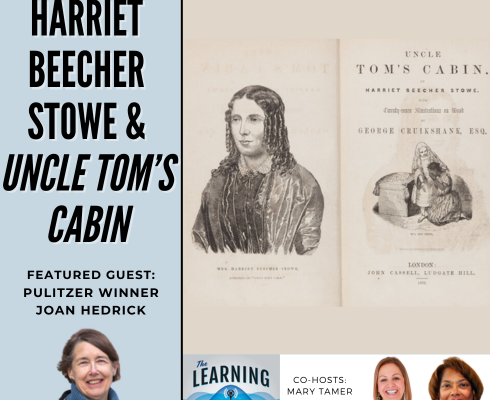
Pulitzer Winner Joan Hedrick on Harriet Beecher Stowe & Uncle Tom’s Cabin

Dr. Adrian Mims on The Calculus Project & STEM
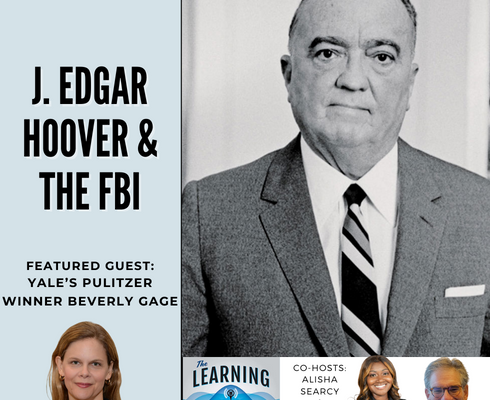
Yale University Pulitzer Winner Beverly Gage on J. Edgar Hoover & the FBI
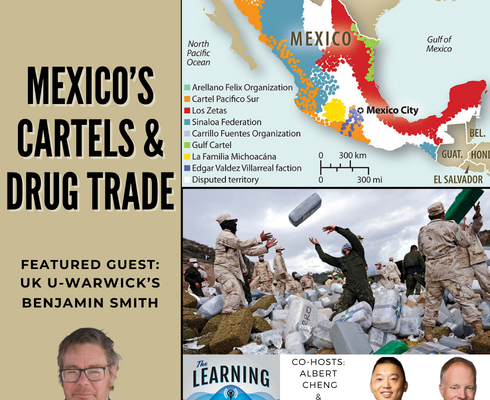
UK U-Warwick’s Benjamin Smith on Mexico’s Cartels & Drug Trade
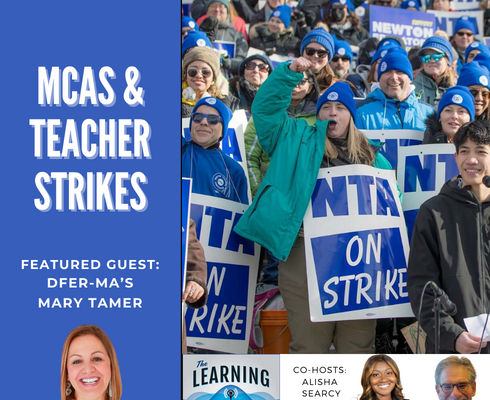
DFER-MA’s Mary Tamer on MCAS & Teacher Strikes
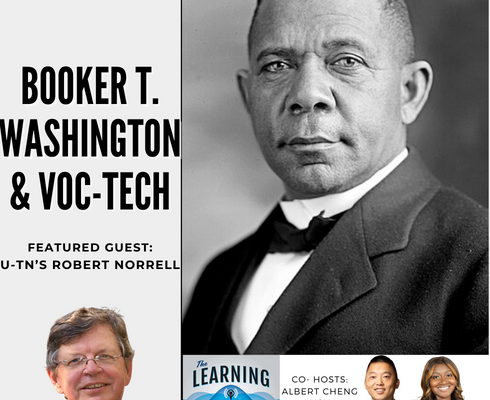
U-TN’s Robert Norrell on Booker T. Washington & Voc-Tech

BC’s Dr. Matthias von Davier on TIMSS & K-12 Global STEM

ExcelinEd’s Dr. Cara Candal on National School Choice Week
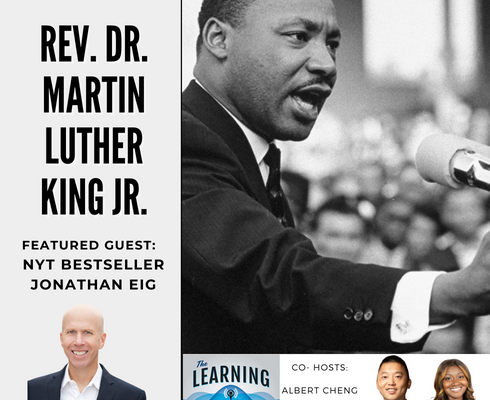
NYT Bestseller Jonathan Eig on the Rev. Dr. Martin Luther King, Jr.

Olympic Track Medalist Gabby Thomas
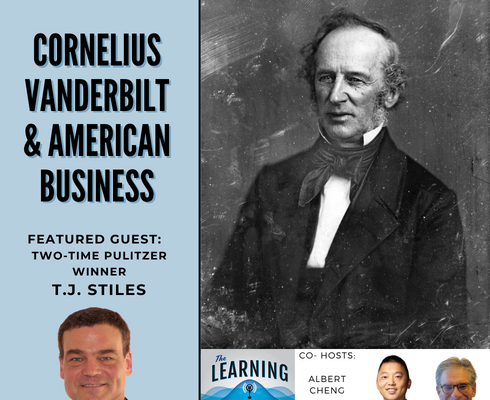
Two Time Pulitzer Winner T.J. Stiles on Cornelius Vanderbilt & American Business


